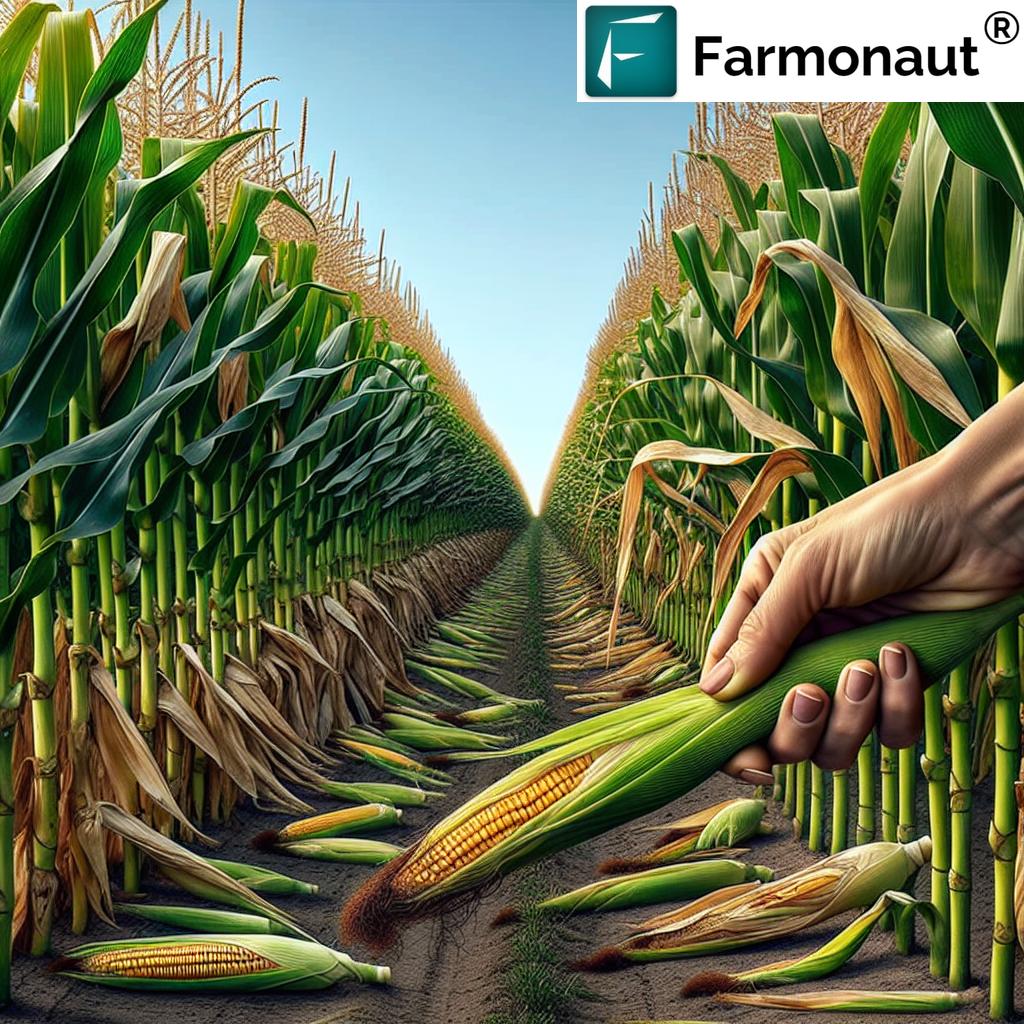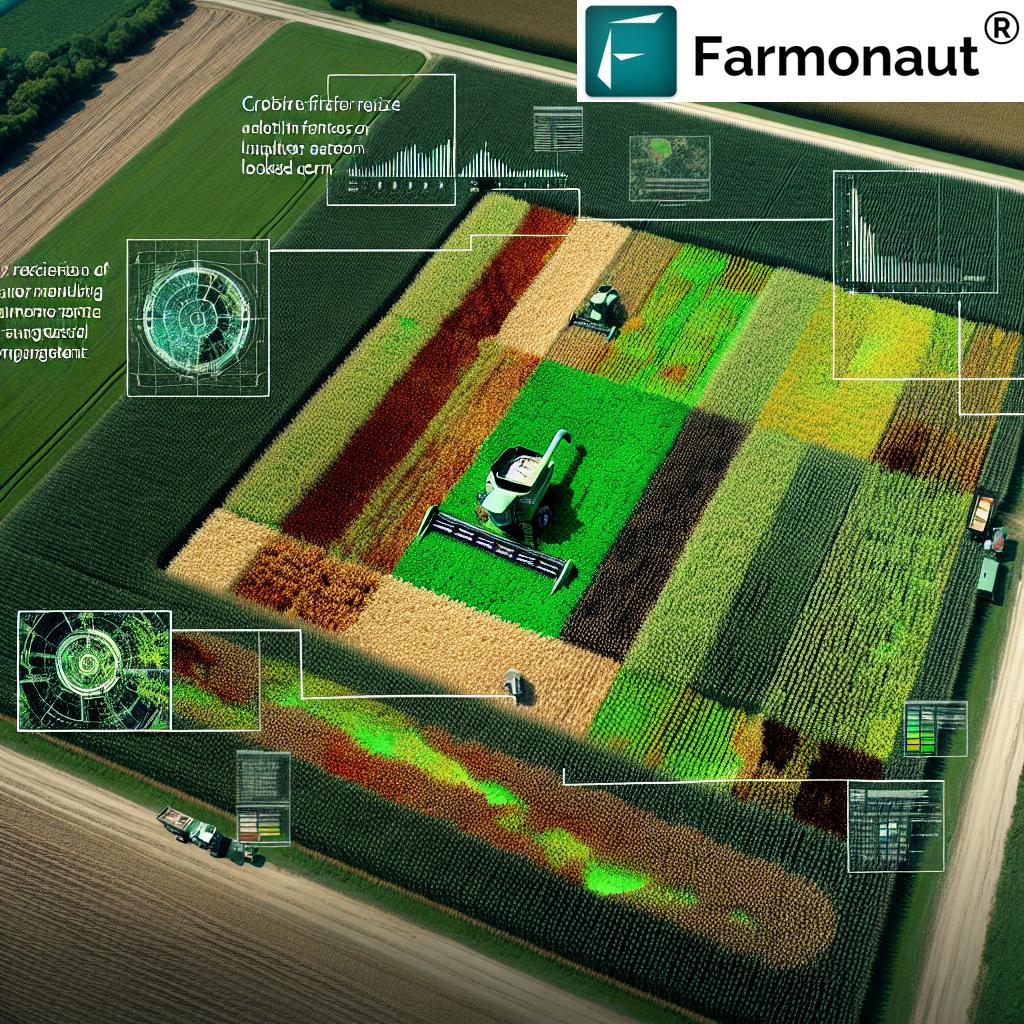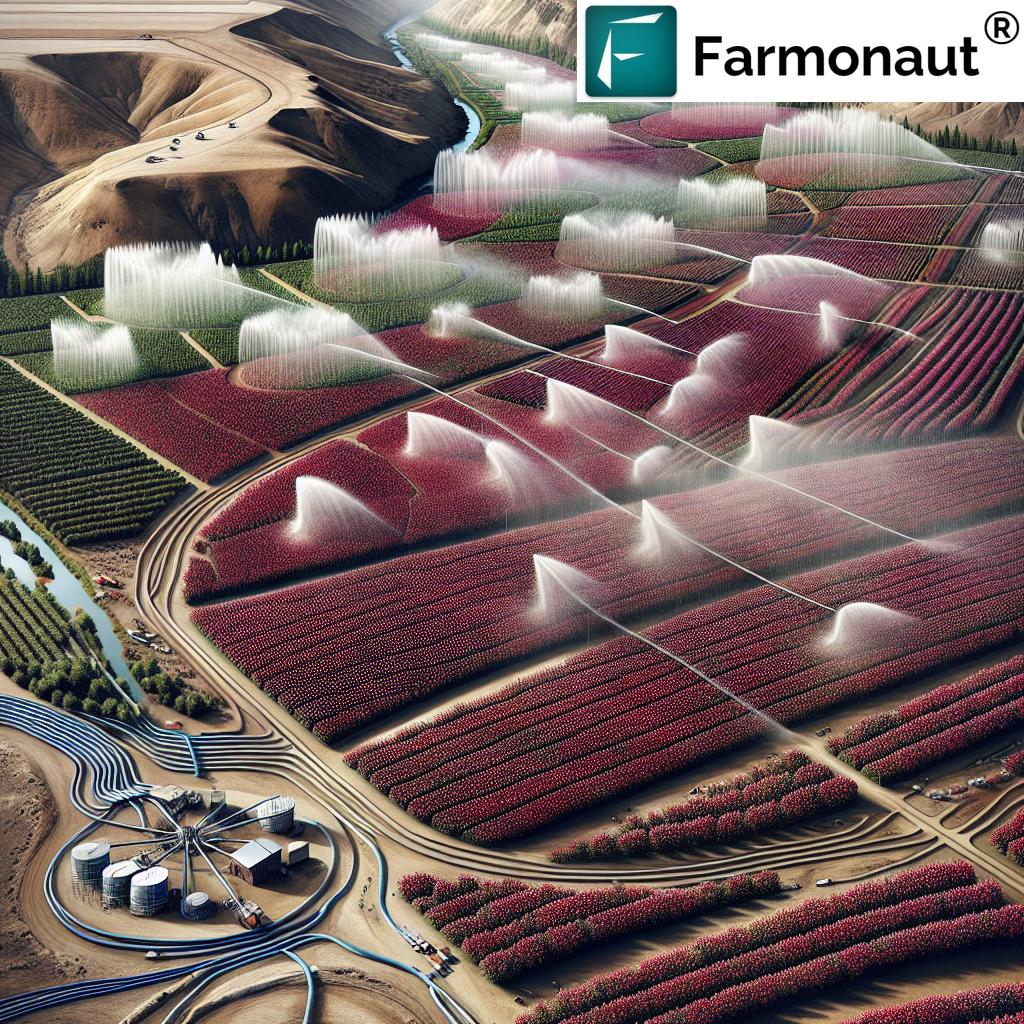Ultimate Guide: Mastering Corn Stalk Lodging Management in Iowa for Higher Yields

“Corn stalk lodging can reduce yields by up to 25% in severely affected fields.”
Welcome to our comprehensive guide on corn stalk lodging management in Iowa. As farmers and agricultural experts, we understand the critical importance of preventing yield loss and optimizing harvest in corn production. Corn stalk lodging is a significant challenge that can drastically impact your crop’s success. In this ultimate guide, we’ll explore the causes of stalk lodging in corn and provide you with effective strategies to manage this issue and boost your yields.
At Farmonaut, we’re committed to empowering farmers with cutting-edge technology and data-driven insights. Our satellite-based farm management solutions can play a crucial role in monitoring and managing corn stalk lodging. Let’s dive into the world of corn stalk health and discover how you can master lodging management for higher yields.
Understanding Corn Stalk Lodging
Corn stalk lodging occurs when corn plants fall over or break below the ear, making harvesting difficult and potentially reducing yields. This phenomenon is a complex issue influenced by various factors, including environmental conditions, plant genetics, and management practices.
- Carbohydrate demand during grain fill
- Stress factors like drought and low sunlight
- Genetic differences in corn hybrids
- Nutrient imbalances, particularly potassium deficiency
- Disease and pest pressure
Understanding these factors is crucial for developing effective corn stalk lodging management strategies. Let’s explore each of these in detail.
The Role of Carbohydrate Demand in Stalk Lodging
One of the primary causes of stalk lodging in corn is the high carbohydrate demand during the grain fill period. During this critical stage, the developing ears require a substantial amount of energy, which can lead to the remobilization of carbohydrates from the stalks to the kernels.
This process, known as photosynthate partitioning, can weaken the stalks if the plant cannot produce enough carbohydrates through photosynthesis to meet the demand of both the developing grain and maintaining stalk integrity. Factors that can exacerbate this issue include:
- High plant populations
- Excessive nitrogen fertilization
- Prolonged cloudy weather during grain fill
- Leaf diseases that reduce photosynthetic capacity
To manage carbohydrate demand and reduce the risk of stalk lodging, consider the following strategies:
- Optimize plant population based on hybrid characteristics and field conditions
- Implement balanced fertilization practices
- Choose hybrids with strong stalk strength ratings
- Control foliar diseases through timely fungicide applications
Environmental Stress Factors and Stalk Lodging
Environmental stresses play a significant role in corn stalk lodging. Drought, excessive moisture, and low sunlight conditions can all contribute to weakened stalks and increased lodging risk.
Drought Stress: Water deficit during critical growth stages can lead to reduced photosynthesis and increased remobilization of carbohydrates from stalks to ears. This weakens the stalk and makes it more susceptible to lodging.
Excessive Moisture: Waterlogged soils can lead to shallow root systems and nutrient deficiencies, both of which contribute to weaker stalks.
Low Sunlight: Extended periods of cloudy weather can reduce photosynthesis, leading to lower carbohydrate production and potentially weaker stalks.
To mitigate these environmental stressors:
- Implement proper irrigation management in drought-prone areas
- Improve field drainage to prevent waterlogging
- Consider using drought-tolerant hybrids in areas prone to water stress
- Adjust planting dates to optimize sunlight exposure during critical growth stages
Genetic Factors in Corn Stalk Lodging
The genetic makeup of corn hybrids plays a crucial role in their susceptibility to stalk lodging. Different hybrids exhibit varying levels of stalk strength, disease resistance, and stress tolerance. When selecting corn hybrids for your Iowa fields, consider the following genetic traits:
- Stalk strength ratings
- Root lodging resistance
- Disease resistance, particularly to stalk rots
- Stress tolerance (drought, heat, etc.)
- Stay-green characteristics
Work closely with seed companies and local agronomists to choose hybrids that are well-suited to your specific growing conditions and have a proven track record of strong stalk health in Iowa.
Nutrient Management for Strong Stalks
Proper nutrient management is essential for developing strong, healthy corn stalks that can resist lodging. Pay particular attention to the following nutrients:
Potassium (K): Adequate potassium levels are crucial for stalk strength. Potassium deficiency can lead to weakened stalks and increased susceptibility to lodging.
Nitrogen (N): While nitrogen is essential for corn growth and yield, excessive nitrogen can lead to tall, spindly plants more prone to lodging. Balance is key.
Phosphorus (P): Proper phosphorus levels support root development, which is crucial for anchoring the plant and preventing root lodging.
To optimize nutrient management:
- Conduct regular soil tests to assess nutrient levels
- Implement precision fertilizer applications based on soil test results and yield goals
- Consider using split nitrogen applications to match plant demand throughout the growing season
- Utilize Farmonaut’s satellite-based crop health monitoring to identify potential nutrient deficiencies early
Corn Field Scouting Techniques for Stalk Strength Assessment
Regular field scouting is crucial for assessing stalk strength and identifying potential lodging issues before they become severe. Here are some effective scouting techniques:
- Push Test: Walk through your fields and randomly select plants. Push the top of the plant 30 degrees from vertical. If it doesn’t snap back to vertical or breaks, it’s at risk of lodging.
- Pinch Test: Pinch the stalk at the first or second elongated internode above the ground. If it collapses easily, it’s a sign of potential lodging.
- Visual Inspection: Look for signs of stalk rot, such as discoloration or soft spots on the lower internodes.
- Root Assessment: Dig up a few plants to examine root health. Poor root development can lead to root lodging.
Implement a regular scouting schedule, especially as the crop approaches maturity. Early detection of potential lodging issues allows for timely management decisions, such as adjusting harvest plans or prioritizing at-risk fields for earlier harvest.
Efficient Corn Harvesting Methods to Minimize Lodging Impact
When dealing with lodged corn, efficient harvesting methods can help minimize yield losses. Consider the following strategies:
- Adjust Combine Settings: Slow down ground speed and adjust header height to pick up lodged plants effectively.
- Use Specialized Equipment: Consider investing in corn reels or snouts designed for lodged corn.
- Harvest Against the Lean: When possible, harvest in the direction opposite to how the corn is leaning for better pickup.
- Prioritize Severely Affected Areas: Harvest areas with the worst lodging first to prevent further losses.
Remember, timing is crucial. Don’t delay harvest if significant lodging is present, as this can lead to increased ear drop and quality issues.
“Proper corn stalk lodging management can potentially increase harvest efficiency by 15-20%.”
Managing Corn Carbohydrate Demand for Stronger Stalks
Balancing the carbohydrate demand between developing ears and maintaining stalk integrity is key to preventing lodging. Here are some strategies to manage carbohydrate demand:
- Optimal Plant Population: Avoid excessive plant densities that can lead to competition for resources and weaker stalks.
- Balanced Fertilization: Ensure proper nutrient balance to support both grain fill and stalk health.
- Timely Planting: Plant at the optimal time for your region to allow for proper plant development before grain fill.
- Stress Mitigation: Implement practices that reduce plant stress, such as proper irrigation and disease management.
By managing carbohydrate demand effectively, you can help ensure that your corn plants have the resources needed to maintain strong stalks throughout the growing season.
Leveraging Technology for Corn Stalk Lodging Management
Modern technology offers powerful tools for managing corn stalk lodging. At Farmonaut, we provide advanced satellite-based solutions that can significantly enhance your lodging management efforts:
- Real-time Crop Health Monitoring: Our satellite imagery can help you identify areas of potential stress or nutrient deficiencies that may lead to lodging.
- AI-driven Insights: Our Jeevn AI advisory system provides personalized recommendations for crop management, including strategies to reduce lodging risk.
- Weather Forecasting: Access accurate weather predictions to plan your management activities and anticipate potential lodging events.
By integrating these technologies into your corn management practices, you can make more informed decisions and take proactive steps to prevent lodging.
Best Practices for Corn Stalk Lodging Prevention in Iowa
To effectively prevent corn stalk lodging in Iowa, consider implementing these best practices:
- Choose hybrids with strong stalk ratings and disease resistance
- Implement crop rotation to break disease cycles and improve soil health
- Maintain optimal soil fertility based on regular soil tests
- Practice timely planting to ensure proper plant development
- Manage plant populations based on hybrid characteristics and field conditions
- Control weeds to reduce competition for nutrients and water
- Implement integrated pest management to control stalk-boring insects
- Use foliar fungicides when necessary to control stalk-rotting pathogens
- Consider using plant growth regulators in high-risk situations
By combining these practices with the insights provided by Farmonaut’s satellite-based monitoring, you can create a robust strategy for managing corn stalk lodging in your Iowa fields.
The Impact of Climate Change on Corn Stalk Lodging in Iowa
Climate change is increasingly affecting corn production in Iowa, with potential implications for stalk lodging. Consider the following climate-related factors:
- Increased Weather Variability: More frequent extreme weather events can stress corn plants and increase lodging risk.
- Shifting Growing Seasons: Changes in temperature and precipitation patterns may affect planting dates and crop development.
- New Pest and Disease Pressures: Warmer temperatures may lead to the emergence of new pests and diseases that can weaken stalks.
To adapt to these changes:
- Stay informed about climate trends and projections for your area
- Consider adopting climate-resilient corn hybrids
- Implement conservation practices to improve soil health and water retention
- Use Farmonaut’s weather forecasting and crop monitoring tools to make timely management decisions
Economic Considerations in Corn Stalk Lodging Management
Effective corn stalk lodging management not only protects yields but also has significant economic implications. Consider the following economic factors:
- Yield Protection: Preventing lodging can safeguard your yield potential and income.
- Harvest Efficiency: Reduced lodging leads to faster, more efficient harvesting, saving time and fuel costs.
- Quality Preservation: Minimizing lodging helps maintain grain quality, potentially securing better market prices.
- Input Optimization: Proper management can lead to more efficient use of inputs, improving overall profitability.
When considering investments in lodging prevention strategies, weigh the costs against the potential economic benefits of improved yields and harvest efficiency.
Integrating Corn Stalk Lodging Management with Precision Agriculture
Precision agriculture techniques can significantly enhance your corn stalk lodging management efforts. Here’s how you can integrate these advanced approaches:
- Variable Rate Technology (VRT): Use VRT for precise application of nutrients and seeds, optimizing plant populations and reducing lodging risk in different field zones.
- GPS-guided Equipment: Implement GPS-guided planting and harvesting to minimize compaction and improve overall field management.
- Drone Scouting: Utilize drones for efficient field scouting, allowing for early detection of potential lodging issues.
- Data Analytics: Leverage Farmonaut’s data analytics capabilities to interpret satellite imagery and make data-driven decisions about lodging management.
By combining these precision agriculture techniques with Farmonaut’s satellite-based solutions, you can create a comprehensive approach to managing corn stalk lodging in your Iowa fields.
Explore Farmonaut’s API for custom integrations
Corn Stalk Lodging Risk Factors and Management Strategies
| Risk Factor | Estimated Risk Level | Management Strategy | Scouting Indicators | Harvest Considerations |
|---|---|---|---|---|
| High carbohydrate demand during grain fill | High | Balanced fertilization, optimal planting density | Thin stalks, pale leaves | Prioritize early harvest |
| Drought stress | High | Irrigation management, drought-tolerant hybrids | Leaf rolling, premature senescence | Monitor moisture levels, adjust combine settings |
| Genetic susceptibility | Medium | Select hybrids with strong stalk ratings | Consistent lodging across hybrid blocks | Harvest susceptible hybrids first |
| Nutrient imbalance (esp. potassium deficiency) | Medium | Soil testing, precision nutrient application | Leaf chlorosis, stunted growth | Assess stalk strength before harvest |
| Disease pressure (e.g., stalk rots) | Medium to High | Fungicide application, crop rotation | Stalk discoloration, soft stalks | Harvest infected areas promptly |
Future Trends in Corn Stalk Lodging Management
As we look to the future of corn production in Iowa, several emerging trends and technologies are poised to revolutionize stalk lodging management:
- Gene Editing: Advanced gene editing techniques may lead to the development of corn varieties with enhanced stalk strength and lodging resistance.
- AI and Machine Learning: These technologies will enable more accurate prediction of lodging risks based on environmental data and crop genetics.
- IoT Sensors: In-field sensors could provide real-time data on plant health and environmental conditions, allowing for more timely interventions.
- Robotics: Autonomous robots may be used for precision scouting and targeted management of lodging-prone areas.
Stay informed about these developments and consider how they might be integrated into your corn management practices in the coming years.
Conclusion: Mastering Corn Stalk Lodging Management for Iowa Farmers
Effective corn stalk lodging management is crucial for maximizing yields and ensuring a successful harvest in Iowa. By understanding the complex interplay of factors that contribute to lodging and implementing a comprehensive management strategy, you can significantly reduce the risk of yield losses and improve overall crop performance.
Remember these key points:
- Regularly assess your fields for signs of potential lodging
- Choose appropriate hybrids and implement balanced nutrient management
- Utilize precision agriculture techniques and advanced technologies like Farmonaut’s satellite-based solutions
- Stay informed about climate trends and adapt your practices accordingly
- Consider the economic implications of your lodging management decisions
By mastering corn stalk lodging management, you’ll be well-positioned to achieve higher yields, improve harvest efficiency, and enhance the overall profitability of your corn production in Iowa.

FAQs: Corn Stalk Lodging Management in Iowa
- Q: What is the most common cause of corn stalk lodging in Iowa?
A: While multiple factors contribute, high carbohydrate demand during grain fill, coupled with environmental stresses like drought or excessive moisture, are among the most common causes of corn stalk lodging in Iowa. - Q: How can I determine if my corn is at risk for lodging?
A: Regular field scouting using methods like the push test and pinch test can help assess lodging risk. Also, look for signs of stress, nutrient deficiencies, or disease that may weaken stalks. - Q: What role does hybrid selection play in preventing stalk lodging?
A: Hybrid selection is crucial. Choose hybrids with strong stalk strength ratings, good disease resistance, and adaptability to your specific growing conditions in Iowa. - Q: How can precision agriculture tools help manage corn stalk lodging?
A: Precision agriculture tools, such as Farmonaut’s satellite-based crop monitoring, can help identify stress areas, optimize nutrient application, and provide early warnings of potential lodging issues. - Q: What are the best harvest strategies for fields with lodged corn?
A: For lodged corn, slow down harvest speed, adjust combine settings, consider using specialized equipment like corn reels, and harvest against the direction of the lodging when possible.
Farmonaut Subscriptions for Enhanced Corn Management
To take your corn stalk lodging management to the next level, consider subscribing to Farmonaut’s advanced satellite-based farm management solutions. Our platform offers real-time crop health monitoring, AI-driven insights, and precision agriculture tools tailored to your specific needs.
By leveraging Farmonaut’s technology, you’ll be equipped with the tools and insights needed to make data-driven decisions, optimize your corn production, and effectively manage stalk lodging risks in your Iowa fields.
Explore our API Developer Docs for custom integrations
Remember, successful corn stalk lodging management is an ongoing process that requires vigilance, adaptability, and the right tools. With the strategies outlined in this guide and the support of Farmonaut’s advanced technology, you’re well-equipped to tackle the challenges of corn production in Iowa and achieve higher yields through effective lodging management.
















